Lisbon

Lisbon, Portugal’s stunning capital city, is one of Europe’s most charismatic and vibrant cities, and boasts a rich and varied history, buzzing nightlife and a glorious year-round climate. Sitting on seven hills which offer spectacular city and Atlantic views, Lisbon is based at the mouth of the Tejo, or Tagus river, with most of the city lying on the north bank.
The oldest city in Western Europe, Lisbon was virtually destroyed on 1st November 1755 by the Great Lisbon Earthquake, which brought fires and a devastating tsunami, killing thousands. The rebuilding of Lisbon was charged to the Marquis of Pombal, who created the world’s first grid layout. Lisbon’s neo-classical ‘Pombaline’ style of buildings are named after him.
Lisbon is close to a stunning coastline of sandy beaches, many of which are only a short bus or train ride away. They include the Cascais-Estoril coastline to the west and the Costa da Caparica to the south. Further south is the Serra da Arrabida coastline, where some of Portugal’s most beautiful beaches can be found.
Mountain lovers can enjoy walking trails just 25 km away from Lisbon in the beautiful Sintra mountains, or Serre de Sintra, which lie at the heart of the Sintra-Cascais Natural Park to the west of the city.
City Landmarks and Highlights
There are numerous fascinating landmarks that make Lisbon special. They include the Castelo de São Jorge castle in the colourful Alfama district, which was Portugal’s seat of power for over 400 years.
The Elevador de Santa Justa is an industrial age lift which transports passengers up one of Lisbon’s steepest hills. Within its iron structure are Gothic arches and geometric patterns, while the cabins are lined with polished wood, making it one of Lisbon’s best-loved attractions.
Lisbon’s main avenue is the tree-lined 1.5km-long Avenida da Liberdade, or Avenue of Liberty, which dates from 1880 and is lined with fine shops, cafes and hotels. To its south, the Praça do Comércio is Lisbon’s most magnificent plaza and commercial hub, where merchants used to trade exotic items and spices. Today it hosts the Stock Exchange and certain government ministries, as well as boutique hotels and sophisticated restaurants. The famous shopping street Rua Augusta leads off this plaza.
Further west stands the neoclassical Palácio Nacional da Ajuda, the 19th century royal residence which has been beautifully restored, with 35 lavish staterooms open to visitors including the opulent banquet hall and the grand throne room.
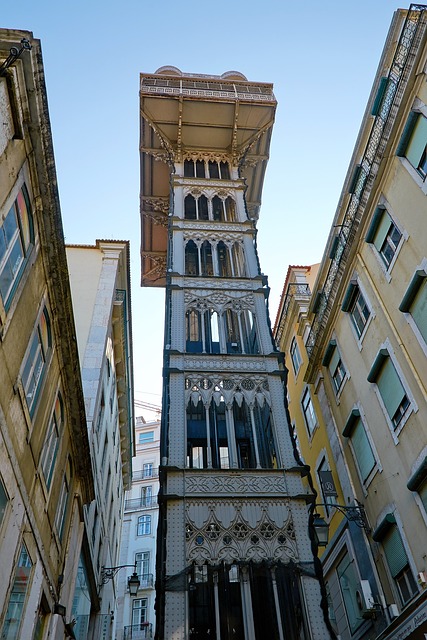
Elevador de Santa Justa
The imposting 16th century Mosteiro dos Jeronimos monastery boasts intricate stone carvings and whimsical Manueline, or Portuguese late Gothic, design styles and sculptures. The iconic Torre de Belém tower is another fine example of the Manueline style of architecture, with Moorish watch towers, ornately carved battlements and even the earliest stone statue of a Rhino.
The Ponte 25 de Abril suspension bridge spans the Tagus Estuary, connecting Lisbon to the commuter districts of Almada to the south. It resembles San Francisco’s Golden Gate Bridge, having been constructed by the same company, and its name commemorates the revolution of Portugal from the Salazar regime on the 25th of April 1974.
Towering above the southern banks of the Tagus Estuary is the Cristo Rei statue, which was inspired by the Christ the Redeemer statue in Rio de Janeiro. It provides unrivalled views of the suspension bridge and the city beyond.
Districts in Lisbon
Spread across seven hills, Lisbon’s twelve bairro, or neighbourhoods, offer something for everyone, with each enjoying its own distinct ambience. Here are some of the most interesting:
Baixa Pombalina: Lisbon’s shopping and banking centre which is also home to the city’s largest park, Eduardo VII. This vibrant and characterful district is at the heart of the city, and filled with grand plazas, bustling shopping streets and classical ‘Pombaline’ style buildings.
Chiado: Located between the Baixa and the Bairro Alto districts, this is the place for shopping, theatres and contemporary art. On Rua Garrett sits the Café A Brasileira, famed as a haunt of the intellectual and artistic elite, including legendary Portuguese poet Fernando Pessoa.
Bairro Alto: This bohemian neighbourhood is home to quirky shops, bars and live music venues. The Gardens of São Pedro de Alcântara and Santa Catarina provide panoramic city views.
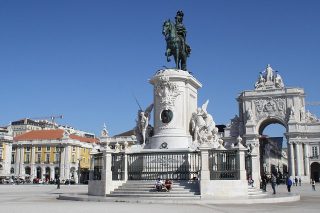
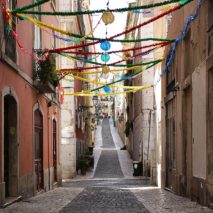
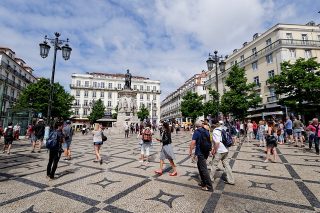
Alfama: This oldest of Lisbon’s districts retains its medieval atmosphere thanks to its dense rock foundation that withstood the 1755 earthquake. Here you’ll find winding, cobblestone streets, modest squares and traditional Moorish whitewashed houses, as well as many of Lisbon’s most iconic historic buildings. In this fashionable and artisan district, steep climbs are rewarded with stunning panoramic views. It is also home to the twice-weekly Feira da Ladra flea market, which has been held for over 500 years.
Mouraria: The Moorish Quarter is a multicultural neighbourhood where Asian, African and Arabic shops and restaurants surround bustling Martim Moniz square. Here, sloping cobbled streets are lined with centuries-old houses, and the area is known as the birthplace of Fado, the traditional Portuguese music.
Belém: Home to Praça do Império, the country’s largest square, this neighbourhood is also where many of Lisbon’s most iconic tourist attractions can be found, including the Mosteiro dos Jeronimos and the Torre de Belem. Filled with parks, tree-lined plazas and scenic riverside walks, it is much calmer than central Lisbon.

Alcântara: Once a thriving port, this area is now a busy nightlife hub with waterfront eateries and clubs based in converted warehouses near the 25 de Abril bridge. It also attracts those seeking loft-style living and river views.
Parque das Naçōes: Lisbon’s newest district lies to the north-east, and was transformed from an industrial wasteland into the location of the 1998 World Expo. This futuristic, pedestrian-friendly commercial and residential hub has many restaurants, gardens, the world’s second largest aquarium and a 20,000-seat arena hosting concerts and sporting events. Today, the Park of Nations has it all: Portugal’s tallest building, a marina, a major shopping centre, Lisbon’s only casino and a cable car.
Getting Around in Lisbon
Lisbon offers an excellent transport network, with a metro, buses, trams, funiculars, suburban trains and even boats. To climb the famous hills, funiculars and elevators have become the city’s most iconic forms of transportation.
Lisbon’s efficient metro network has four interconnecting lines, serving the airport (Red Line), Baixa and Chiado (Blue Line), Mouraria and Alvalade (Green Line), and Saldanha and Campo Pequeno (Yellow Line).
There are many buses and trams that weave their way around the city, the most famous of which is Tram 28E, which winds through the historic neighbourhoods of Mouraria and Alfama. Three funiculars, or ascensores, take care of Lisbon’s uphill climbs, while the famous Santa Justa elevator connects Baixa to Largo do Carmo in Chiado.
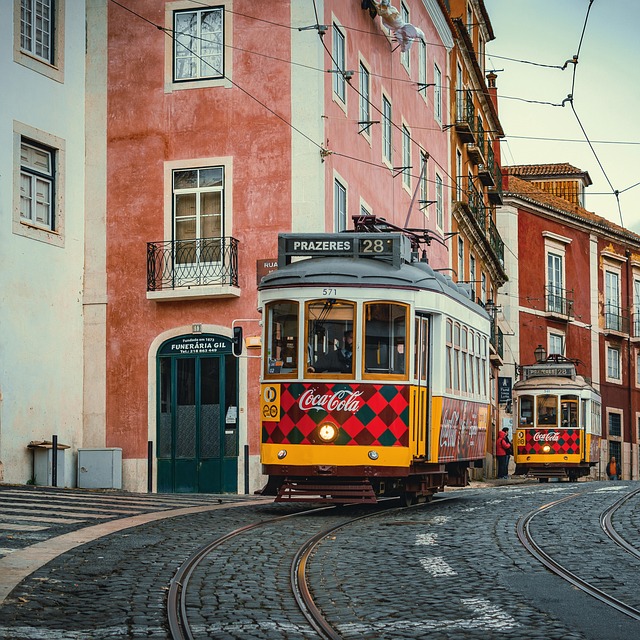
Suburban trains on the Cascais Line depart from Cais do Sodré and connect with Belém in less than 10 minutes. The Azambuja Line from Santa Apolónia takes eight minutes to reach the eastern side of the city.
Five boat routes connect the two sides of the Tagus River, and are the fastest, cheapest and easiest way to get to the south bank, departing from Terreiro do Paço, Cais do Sodré and Belém.
Schools in Lisbon
If you are moving to Lisbon with your family, there are several good international schools, including the British School of Lisbon, the Carlucci American International School of Lisbon, the International Preparatory School, Greene’s Tutorial College and St. Julian’s School.
Culture in Lisbon
Lisbon offers a great deal of culture, from modern galleries to classical or contemporary theatres and museums. An indispensable part of Portuguese culture is Fado, a haunting and emotional style of music sung by a lone female singer accompanied by a classical guitar. Fado represents the sorrow experienced by the wives and mothers of sailors lost at sea, and captures this essence of longing, missing and fate.
Beyond Lisbon
There are several areas around Lisbon that make for wonderful day trips, weekend breaks or which are even possible to commute from. Arguably the most popular is Cascais, once known as the Portuguese Riviera thanks to its beaches, shopping, restaurants and nightlife. Just a one-hour train ride from Lisbon, Cascais is home to several gated communities, such as the Quinta da Marinha, with its own golf courses and gym, Quinta da Patino and Penha Longa, which combine security with shared or private pools, set in attractive landscaping.
